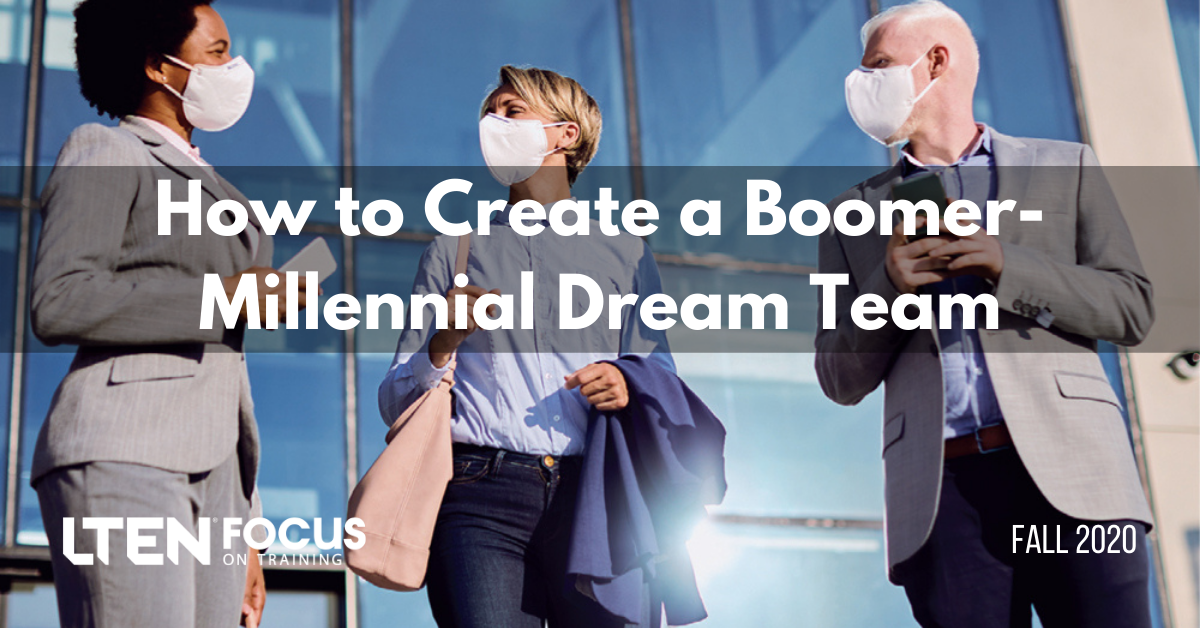
FEATURE STORY – By Dr. Shawn Andrews
How to Create a Boomer-Millennial Dream Team

The diversity of our world and workplace has changed dramatically in the past decade.
Boomers just do not understand technology. Gen Xers lack loyalty and never follow the rules. Millennials want to advance without putting in the work.
These are common stereotypes about the generations that we have all heard – or maybe even believe.
Tracking Trends
The diversity of our world and workplace has changed dramatically in the past decade, driven by a few significant global demographic trends. First, life expectancy has increased in all countries due largely to improvements in public health (better medicines, clean water, access to healthcare, etc.) As a result, we are living and working longer than ever before. More older workers are staying in their jobs, retiring later in life or not retiring at all.
When looking at global populations, age has always been represented as a pyramid. The youngest generation is at the bottom of the pyramid and are the most numerous. The next level up is the generation before them and second in overall number of people. The level above that is a bit smaller and older, and at the top of the pyramid are the oldest citizens.
In the past few years, this traditional “pyramid” has shifted to a “pillar” with roughly equal proportions of each generation from top to bottom. This shift is driven by the fact that we are working and living longer. Some regions, like Europe, are top heavy and have more older workers than younger, which has implications for filling future leadership gaps.
The second global trend is that birth rates have declined in developed countries like the United States and the European Union, but are surging in developing countries. High birth rates cause migration across borders to find employment. This means that we will continue to see more diversity in our workforce across a wide range of age, race, ethnicity, gender and disabled workers with disabilities.
Third, 2020 has long been predicted as the year that we will have five generations working side-by-side. These generations are the traditionalists or veterans (1900-1945), baby boomers (1946-1964), Generation X (1965-1980), millennials (1981-1996) and Generation Z (1997-2010). Note that the exact years for millennials and gen Z vary widely depending on the source.
We are currently midway through the next generation, Generation Alpha, with the oldest being 9 years, so they are not yet counted in the workforce. On the other end of the spectrum, the youngest traditionalist would be 75 years old this year.
 Perceptions at Work
Perceptions at Work
More diversity at work increases the potential for more biases – and ageism is a significant and current talent issue. Many who are 50-plus cannot find a job, despite impeccable credentials and work history. As a training professional, how many 50- plus new hires are in your training classes? Part of the reason for this is that there simply are too many people looking for work now with too few jobs, compared to 10 years ago.
Another key driver for ageism is commonly held stereotypes or biases. When millennials first entered the workforce around 2000, we heard mostly negative perceptions. They were entitled, lazy, self-centered, lacked ambition, with no respect for chain of command, needing constant recognition, job hoppers and even spoiled and whiny.
As professor teaching millennials in business school, I have been pleasantly surprised. I have experienced just the opposite in this generation and have seen many positive attributes. They are hard workers, confident, tech-savvy, challenge the status quo, proactive communicators, open to learning new things, value collaboration and teamwork, and they are intolerant of a lack of diversity in organizations. They also value work-life integration, flexibility and meaning in their work. I believe these characteristics will bode well for all of us and help make our workplaces more accommodating to different styles and diversity.
Now, think of some boomer strengths. I often hear experienced, wise, knowledgeable, loyal and seeks stability. When I press for more, many people have a difficult time thinking of boomer strengths, but there are just as many positive boomer characteristics as millennials.
Boomers are loyal and have a strong work ethic that can counter much of the frequent job-hopping that we see with younger generations. Boomers are both goal- and serviceoriented and are masters at building interpersonal relationships. Because of this, they have refined their time management and negotiation skills from years of experience working directly with people and less with technology and are adept at addressing conflict. Boomers are ambitious, resourceful and have a strong ability to learn because they have done lots of different jobs. They also tend to be more focused (less multitasking) than their younger counterparts.
From an emotional intelligence perspective, boomers offer many benefits. In general, as we age, our emotional intelligence increases. Because of their accumulation of life experiences, boomers tend to be more empathic, have better stress tolerance and impulse control, and are generally more optimistic than millennials.
The Dream Team
So, how can you create a boomermillennial dream team in your organization? There are many ways we can maximize the interactions of older and younger workers.
 Make sure you proactively communicate with each other to address any misperceptions or differences in opinion, attitude, expectations or beliefs. This is
Make sure you proactively communicate with each other to address any misperceptions or differences in opinion, attitude, expectations or beliefs. This is
important because of the commonly held stereotypes addressed above.
Coaching and mentoring across age groups is essential. There is much each can learn from the other. We typically imagine that the young can help the old understand technology and the old can impart general wisdom, but it goes further than that. Boomers can help younger workers control their work (schedules, time management, workload, and prioritizing). They can also help them control their impulses and show restraint when needed, how to navigate and address conflict, and how to be more empathetic.
Be sure to provide regular feedback, especially if you are in a leadership position, as millennials prefer to receive consistent feedback and communication. Try to understand their values, which is a key element in job retention for younger generations. Boomers can be role models. Given their years of experience, accumulated knowledge and skills, older workers are in the best position to show younger colleagues what success can look like.
Millennials can help boomers in many ways too. Other than the obvious technology lessons that younger workers can impart, they can help older workers build diverse relationships and networks. In general, those over the age of 50 simply maintain their current networks and fail to build new networks. Thus, their networks become increasingly homogenous, static and comfortable, which does not serve them well when they need to transform.
Coaching and mentoring across age groups is essential. There is much each can learn from the other.
When young people start their careers, it is second nature to meet new people, build networks and actively find coaches and mentors. Millennials can help coach their older colleagues in how to create and maintain diverse networks (most likely using technology). As our work life expands, everyone goes through changes and transitions. Having the skills and transformational assets to support this change tends to be strongest in the young — and as people live longer, they need to display these skills throughout their lives.
I would also advise millennials to respect the wisdom and knowledge of older workers and be willing to learn from them. Previous generations have already been down the road you are on and can help you navigate the path more easily. Keep an open mind and do not make assumptions that older workers cannot learn new things.
Try to understand older workers’ values and where they stem from. Values are shaped and influenced by the formative events that occur in each generation — and each grew up with very different economic, political, social and cultural circumstances.
Redefining Wisdom
The generational landscape is exciting and dynamic, and it promises to redefine much of the conventional wisdom about work, organizational success, personal accomplishment and more. As we scan the workplace of the future, we see that everything we know about work — where we work, how we work, what skills we need to stay employable, what technologies we use to connect with colleagues and customers — is changing.
The best way to navigate these changes is by leveraging and maximizing the strengths of both our older and younger workers to create a true dream team.
Join Us for More!
You’ve heard about generational differences. And you may have witnessed or experienced ageism yourself. But is it possible to leverage generational differences and reduce ageism? Absolutely.
Join us for “Overcoming Bias and Ageism: Creating a Boomer‐Millennial Dream Team.” This free LTEN webinar on Friday, Nov. 6, will feature Dr. Shawn Andrews, author of The Power of Perception: Leadership, Emotional Intelligence, and the Gender Divide. Shawn will show you how to create a Boomer‐Millennial Dream Team at your organization!
Register for free at www.L‐TEN.org/webinars.
Dr. Shawn Andrews is a keynote speaker, organizational consultant, business school professor and author. Email her at shawn@drshawnandrews.com.








